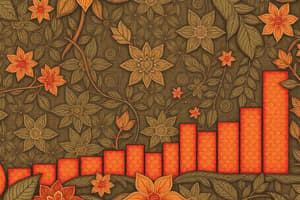Podcast
Questions and Answers
What is the mode of the combined IQ scores for Classes A & B?
What is the mode of the combined IQ scores for Classes A & B?
- 120
- 131
- 93
- 109 (correct)
Which test is NOT categorized as a normality test?
Which test is NOT categorized as a normality test?
- Q-Q probability plot
- Shapiro-wilk test
- Kolmogrov-Smirnov test
- ANOVA (correct)
When can parametric tests be used according to the description?
When can parametric tests be used according to the description?
- When the median represents the center of the distribution
- When the data is non-normally distributed
- When the sample size is very large
- When the mean represents the center of the distribution (correct)
Which of the following conditions is necessary for normality tests?
Which of the following conditions is necessary for normality tests?
What does the central limit theorem state?
What does the central limit theorem state?
Which graphical method is NOT used for checking normality?
Which graphical method is NOT used for checking normality?
In what situation is the normality assumption considered most crucial?
In what situation is the normality assumption considered most crucial?
What does it mean if the mode is present multiple times in a dataset?
What does it mean if the mode is present multiple times in a dataset?
Which value represents the center of a distribution if the mean is not appropriate?
Which value represents the center of a distribution if the mean is not appropriate?
Which of the following is considered a characteristic of the standard normal distribution?
Which of the following is considered a characteristic of the standard normal distribution?
What is the median of the IQ scores for Class A based on the provided data?
What is the median of the IQ scores for Class A based on the provided data?
Which of the following correctly describes the mean in the context of the provided data?
Which of the following correctly describes the mean in the context of the provided data?
What is indicated by the term 'outlier' in the context of the IQ data?
What is indicated by the term 'outlier' in the context of the IQ data?
How is the interquartile range defined based on the context provided?
How is the interquartile range defined based on the context provided?
What percentage of cases are above the median value?
What percentage of cases are above the median value?
Which statement accurately defines 'mode' in the statistical context provided?
Which statement accurately defines 'mode' in the statistical context provided?
Considering the provided data set, which score can be identified as an outlier?
Considering the provided data set, which score can be identified as an outlier?
In statistics, what does a score at the 50th percentile represent?
In statistics, what does a score at the 50th percentile represent?
Which type of data is characterized by attributes such as sex or malocclusion?
Which type of data is characterized by attributes such as sex or malocclusion?
What does the term 'class A' refer to in this statistical context?
What does the term 'class A' refer to in this statistical context?
Why is the interquartile range a useful statistic?
Why is the interquartile range a useful statistic?
What is the primary purpose of measures of central tendency?
What is the primary purpose of measures of central tendency?
Which of the following is NOT a measure of variation?
Which of the following is NOT a measure of variation?
What type of quantitative data consists of whole numbers only?
What type of quantitative data consists of whole numbers only?
What does the acronym SPSS originally stand for?
What does the acronym SPSS originally stand for?
Which statement about the mean is correct?
Which statement about the mean is correct?
Which of the following is an example of continuous data?
Which of the following is an example of continuous data?
Which of the following best describes a sample in statistics?
Which of the following best describes a sample in statistics?
Which of the following is NOT one of the four levels of measurement for scales?
Which of the following is NOT one of the four levels of measurement for scales?
What does the term 'percentiles' refer to in descriptive statistics?
What does the term 'percentiles' refer to in descriptive statistics?
In statistical terms, what are observations?
In statistical terms, what are observations?
Which of the following measures is used to summarize the grouping of numbers in a distribution?
Which of the following measures is used to summarize the grouping of numbers in a distribution?
Which description best defines qualitative data?
Which description best defines qualitative data?
What type of statistics focuses on describing data?
What type of statistics focuses on describing data?
Which of the following represents a method for organizing data?
Which of the following represents a method for organizing data?
Which of the following statements about populations is correct?
Which of the following statements about populations is correct?
What distinguishes inferential statistics from descriptive statistics?
What distinguishes inferential statistics from descriptive statistics?
What does the term 'variables' refer to in statistical analysis?
What does the term 'variables' refer to in statistical analysis?
What are the two main types of data classifications in statistics?
What are the two main types of data classifications in statistics?
Which of the following statements about scales is accurate?
Which of the following statements about scales is accurate?
Flashcards
Median
Median
The middle value in a sorted dataset, where half the values are above it and half are below.
Outlier
Outlier
A data point that is significantly different from the rest of the data in a set.
Mean
Mean
The sum of all values in a dataset divided by the number of values.
Interquartile Range
Interquartile Range
Signup and view all the flashcards
Mode
Mode
Signup and view all the flashcards
50th Percentile
50th Percentile
Signup and view all the flashcards
Qualitative Data
Qualitative Data
Signup and view all the flashcards
Quantitative Data
Quantitative Data
Signup and view all the flashcards
Discrete Data
Discrete Data
Signup and view all the flashcards
Continuous Data
Continuous Data
Signup and view all the flashcards
Descriptive Statistics
Descriptive Statistics
Signup and view all the flashcards
Frequency Distribution
Frequency Distribution
Signup and view all the flashcards
Measures of Variation
Measures of Variation
Signup and view all the flashcards
Population
Population
Signup and view all the flashcards
Data
Data
Signup and view all the flashcards
Variable
Variable
Signup and view all the flashcards
Subject
Subject
Signup and view all the flashcards
Sample
Sample
Signup and view all the flashcards
Inferential Statistics
Inferential Statistics
Signup and view all the flashcards
Scale
Scale
Signup and view all the flashcards
Data
Data
Signup and view all the flashcards
Central Tendency
Central Tendency
Signup and view all the flashcards
Central Limit Theorem
Central Limit Theorem
Signup and view all the flashcards
Normal Distribution
Normal Distribution
Signup and view all the flashcards
Standard Normal Distribution
Standard Normal Distribution
Signup and view all the flashcards
Normality Test
Normality Test
Signup and view all the flashcards
Parametric Test
Parametric Test
Signup and view all the flashcards
Non-Parametric Test
Non-Parametric Test
Signup and view all the flashcards
Q-Q Plot
Q-Q Plot
Signup and view all the flashcards
Box Plot
Box Plot
Signup and view all the flashcards
Kolmogorov-Smirnov Test
Kolmogorov-Smirnov Test
Signup and view all the flashcards
Study Notes
Statistical Workshop Series
- The workshop series introduces SPSS, data, and data attributes.
- Workshop 1 focuses on SPSS introduction, data, and data attributes.
SPSS Software
- SPSS originally stood for Statistical Package for the Social Sciences.
- The software name was later changed to Statistical Product and Service Solutions.
Data and Variables
- Data is all collected information needed to answer research questions.
- Variables include outcome, treatment, and study population characteristics.
- Subjects are units that characteristics are measured from.
- Observations are data elements
- Population includes all subjects of interest.
- Sample is a population subset for data collection.
- Descriptive statistics summarize characteristics of a sample or population.
- Inferential statistics use sample data to make inferences about populations.
Sample and Population
- Population: all subjects of interest to researchers.
- Sample: a subset of the population selected for data collection.
- Parameters relate to the population(e.g., population mean).
- Statistics relate to the sample (e.g., sample mean).
Types of Data
- Qualitative data are based on attributes like sex, malocclusion, or color.
- Quantitative data are collected through measurement (e.g., arch length, arch width).
- Discrete data only takes fixed numerical values (e.g., whole numbers).
- Continuous data can take any value within a range. (e.g., decimal or fractional values).
Variables and Data Types
- Variables are characteristics measured from subjects.
- Categorical (qualitative) variables:
- Nominal: unordered categories (e.g., male/female).
- Ordinal: ordered categories. (e.g., mild/moderate/severe pain).
- Numerical (quantitative) variables:
- Discrete: whole numbers (e.g., number of visits).
- Continuous: any value within a range (e.g., height).
Scales of Measurement
- Nominal: categories with no order (e.g., gender).
- Ordinal: categories with an order (e.g., pain level).
- Interval: intervals between values are meaningful but there's no true zero. (e.g., Temperature in Celsius).
- Ratio: intervals between values are meaningful, with a true zero point. (e.g., height).
Central Tendency
- Measures of central tendency describe the "typical" value in data.
- Common measures include:
- Mode: most frequent value.
- Median: middle value (50th percentile).
- Mean: average of all values.
- Mean can be affected by outliers, whereas mode and median are not impacted by outliers.
Measures of Dispersion
- Measures of variation describe the spread or variability of data.
- Examples:
- Range: difference between the maximum and minimum values.
- Variance: average of the squared deviations from the mean.
- Standard Deviation: square root of the variance.
Measures of Location
- Measures of location describe the position of values in the dataset relative to each other
- Examples:
- Percentiles : values below which a particular percent of the data falls, such as the 90th percentile.
- Deciles: values below which a particular decile (10% increments) of the data falls.
- Quartiles: values that divide the data into four equal groups. (Q1, Q2 = Median, Q3).
Probability Distributions
- Normal Distribution (Gaussian Distribution): symmetrical bell-shaped curve.
- Mean, median, and mode are the same.
Central Limit Theorem
- The central limit theorem states that the sum of many independent, identically-distributed random variables will be approximately normally distributed.
- This is useful when taking samples to make inferences about a population.
Summary Statistics (Descriptive)
- Common measures include calculating mean, standard deviation, minimum and maximum values.
Data Handling using SPSS
- Data can be presented in tables or graphs, typically arranged into variables in the dataset.
Statistical Tests
- Parametric tests (e.g., t-tests, ANOVA) require specific data assumptions, like normality.
- Nonparametric tests (e.g., Mann-Whitney U test, Wilcoxon signed-rank test) are less restrictive.
- The choice between parametric and nonparametric tests depends on the characteristics of the data and research question.
Studying That Suits You
Use AI to generate personalized quizzes and flashcards to suit your learning preferences.




